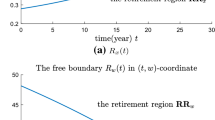Abstract
The question of optimal strategic asset allocation for investors with behavioural utilities saving for retirement is addressed. To date this problem has been studied assuming that an investor is rational in the sense when making investment decisions the preference relation of the investor satisfies all the axioms of choice. Research in behavioural science indicates that investment related decisions of many people do not satisfy the axioms of choice. Our interest is in developing a platform that allows the use of a broader class of utilities that may or may not satisfy the axioms of choice. Such utilities may not be convex. Our interest is in developing a framework algorithm that enables a user considerable flexibility in how their needs may be specified. For illustrative purposes a binomial tree is used to model asset returns, although the method developed can be used with more elaborate models.
Similar content being viewed by others
References
D.E. Bell, H. Raiffa, and A. Tversky, Decision Making—Descriptive, Normative, and Prescriptive Interactions, Cambridge University Press: Cambridge, U.K., 1988.
S. Benartzi and R.H. Thaler, “Myopic loss aversion and the equity premium puzzle,” Quarterly Journal of Economics, vol. 110, no. 1, pp. 75–92, 1992.
J.R. Birge, “Stochastic programming computation and applications,” INFORMS Journal on Computing, vol. 9, no. 2, pp. 111–133, 1997.
Z. Bodie, R.C. Merton, and W.F. Samuelson, “Labor supply flexibility and portfolio choice in life-cycle mode,” Journal of Economic Dynamics and Control, vol. 16 pp. 427–449, 1992.
M.J. Brennan, E.S. Schwartz, and R. Lagnado, “Strategic asset allocation,” Journal of Economic Dynamics and Control, vol. 21, pp. 1377–1403, 1997.
J.Y. Campbell and L.M. Viceira, “Consumption and portfolio decisions when expected returns are time varying,” NBER Working paper No. 5857, 1996.
J. Cox, S. Ross, and M. Rubinstein, “Option pricing: A simplified approach,” Journal of Financial Economics, vol. 7, no. 3, pp. 229, 1979.
G.B. Dantzig and G. Infanger, “Multi-stage stochastic linear programs for portfolio optimization,” Annals of Operations Research, vol. 45, pp. 59–76, 1993.
D. Duffie and T. Zariphopoulou, “Optimal investment with undiversifiable income risk,” Mathematical Finance, vol. 3, no. 2, pp. 135–148, 1993.
C.f. Huang and R.H. Litzenberger, Foundations for Financial Economics, Prentice Hall, Inc.: Englewood Cliffs, New Jersy, 1988.
P.E. Gill, W. Murray, and M.A. Saunders, “User’s guide for SNOPT(Version 4.0): A fortran package for sparse nonlinear programming, Technical Report SOL 86–2, 1998.
P.E. Gill, Walter Murray, and M.A. Saunders, “Snopt: An sqp algorithm for large-scale constrained optimization,” SIAM Journal on Optimization, vol. 12, no. 4, pp. 979–1006, 2002.
G. Infanger, Planning Under Uncertainty—Sovling Large-Scale Stochastic Linear Programs, Boyd & Fraser Publishing Company: Danvers, Massachusetts, 1994.
D. Kahneman and A. Tversky, “Prospect theory: An analysis of decisions under risk,” Econometrica, vol. 47, pp. 313–327, 1979.
I. Karatzas, J.P. Lehoczky, S. Sethi, and S.E. Shreve, “Explicit solution of a general consumption/investment problem,” Mathematics of Operations Research, vol. 11, no. 2, pp. 261–294, 1986.
D.I. Laibson, “Comments on personal retirement saving programs and asset accumulation: Reconciling the evidence,” Studies in the Economics of Aging, NBER Project Report, W5599:106–124, 1998.
D.I. Laibson, A. Repetto, and J. Tobacman, “Self-control and saving for retirement,” Brookings Papers on Economic Activity, vol. 1, pp. 91–196, 1998.
D. Lamberton and B. Lapeyre, “Introduction to Stochastic Calculus Applied to Finance,” Chapman and Hall: London, UK, 1996.
D.G. Luenberger, Investment Science, Oxford University Press: New York, 1998.
A. Mas-Colell, M.D. Winston, and J.R. Green, Microeconomic Theory, Oxford University Press: New York, 1995.
R.C. Merton, “Lifetime portfolio selection under uncertainty: The continuous-time case,” Review of Economics and Statistics, vol. 51, no. 3, pp. 247–257, 1969.
R.C. Merton, “Optimum consumption and portfolio rules in a continuous-time model,” Journal of Economic Theory, vol. 3, no. 4, pp 373–413, 1971.
R.C. Merton, Continuous-Time Finance, Basil Blackwell Inc.: Cambridge, Massachusetts 02142, 1990.
J.M. Poterba, S.F. Venti, and D.A. Wise, “Personal retirement saving programs and asset accumulation: Reconciling the evidence,” NBER Working Paper, W5599, 1997.
S.M. Ross, Stochastic Processes, John Wiley & Sons, Inc.: New York, 1996.
M. Rubinstein, “Implied binomial trees,” The Journal of Finance, vol. 49, no. 3, pp. 771–819, 1994.
P.A. Samuelson, “Lifetime portfolio selection by dynamic stochastic programming,” Review of Economics and Statistics, vol. 51, pp. 239–246, 1969.
W.F. Sharpe, G.J. Alexander, and J.V. Bailey, Investments, Prentice Hall, Inc.: Englewood Cliffs: New Jersey, 1995.
J.B. Shoven, “The location and allocation of assets in pension and conventional savings accounts,” NBER Working Paper No. 7007, 1999.
R.H. Thaler, “Amos Tversky, Daniel Kahneman, and Alan Schwartz,” The effect of myopia and loss aversion on risk taking: an experimental test,” Quarterly Journal of Economics, vol. 5, pp. 297–323, 1992.
A. Tversky, “Additivity, utility and subjective probability,” Journal of Mathematical Psychology, vol. 4, pp. 175–202, 1967.
A. Tversky and D. Kahneman. “Loss aversion in riskless choice: A reference-dependent model,” Quarterly Journal of Economics, vol. 106, no. 4, pp. 1039–1061, 1991.
A. Tversky and D. Kahneman, “Advances in prospect theory: Cumulative representation of uncertainty,” Journal of Risk and Uncertainty, vol. 5, pp. 297–323, 1992.
H.R. Varian, Microeconomic Theory, W.W. Norton and Company, Inc.: New York, 1992.
L.M. Viceira, “Optimal consumption and portfolio choice for long-horizon investors,” PhD thesis, Department of Economics, Harvard University, 1998.
G. Wright, Behavioral Decision Making, Plenum Press:New York, N.Y., 1985.
Author information
Authors and Affiliations
Additional information
Work supported by the National Science Foundation grant CCR-9988205 and Office of Naval Research grant N00014-96-1-0274.
Rights and permissions
About this article
Cite this article
Gupta, A., Murray, W. A Framework Algorithm to Compute Optimal Asset Allocation for Retirement with Behavioral Utilities. Comput Optim Applic 32, 91–113 (2005). https://doi.org/10.1007/s10589-005-2055-6
Issue Date:
DOI: https://doi.org/10.1007/s10589-005-2055-6




